1998 OPEL FRONTERA fuel
[x] Cancel search: fuelPage 5501 of 6000
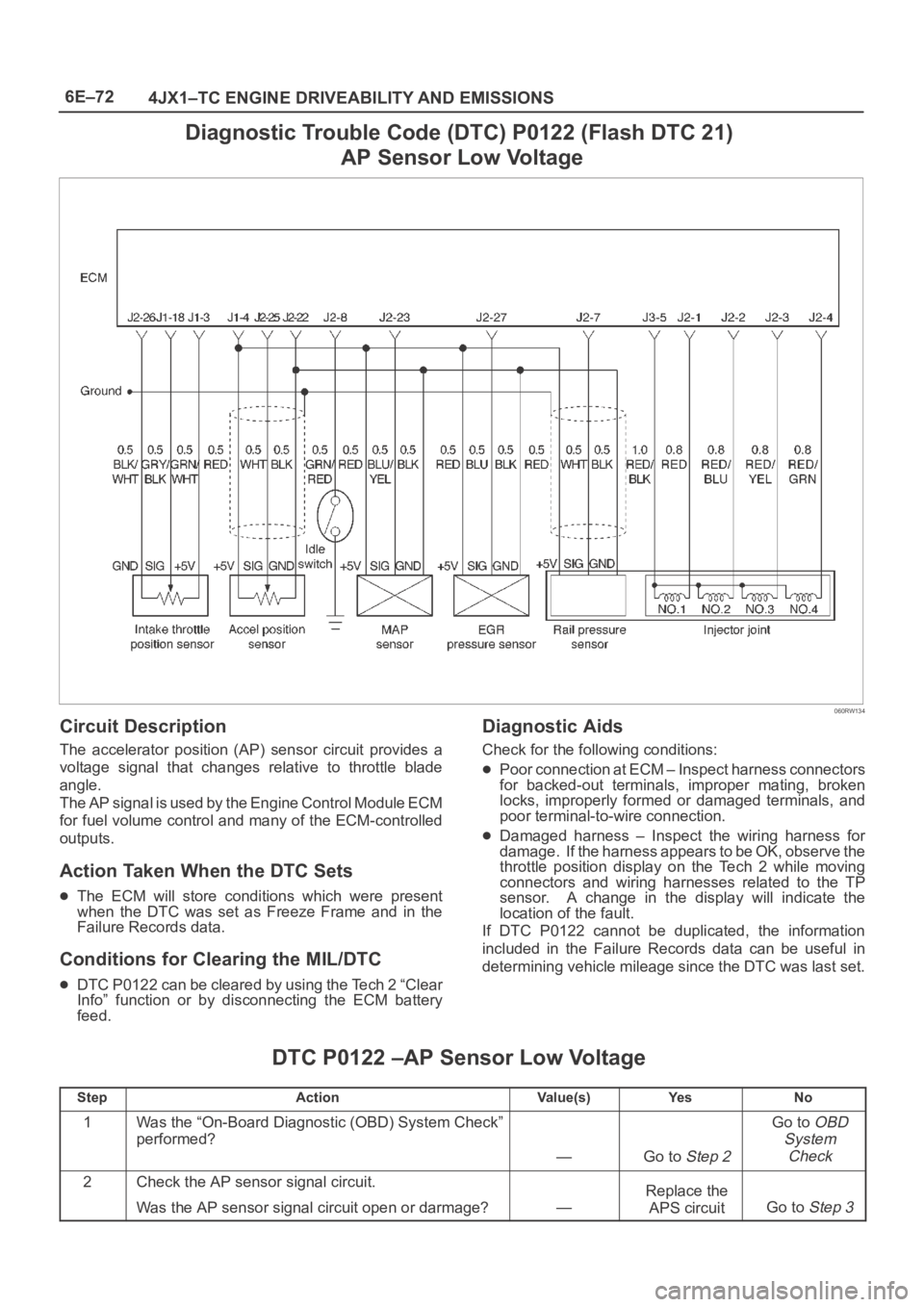
6E–72
4JX1–TC ENGINE DRIVEABILITY AND EMISSIONS
Diagnostic Trouble Code (DTC) P0122 (Flash DTC 21)
AP Sensor Low Voltage
060RW134
Circuit Description
The accelerator position (AP) sensor circuit provides a
voltage signal that changes relative to throttle blade
angle.
The AP signal is used by the Engine Control Module ECM
for fuel volume control and many of the ECM-controlled
outputs.
Action Taken When the DTC Sets
The ECM will store conditions which were present
when the DTC was set as Freeze Frame and in the
Failure Records data.
Conditions for Clearing the MIL/DTC
DTC P0122 can be cleared by using the Tech 2 “Clear
Info” function or by disconnecting the ECM battery
feed.
Diagnostic Aids
Check for the following conditions:
Poor connection at ECM – Inspect harness connectors
for backed-out terminals, improper mating, broken
locks, improperly formed or damaged terminals, and
poor terminal-to-wire connection.
Damaged harness – Inspect the wiring harness for
damage. If the harness appears to be OK, observe the
throttle position display on the Tech 2 while moving
connectors and wiring harnesses related to the TP
sensor. A change in the display will indicate the
location of the fault.
If DTC P0122 cannot be duplicated, the information
included in the Failure Records data can be useful in
determining vehicle mileage since the DTC was last set.
DTC P0122 –AP Sensor Low Voltage
StepActionVa l u e ( s )Ye sNo
1Was the “On-Board Diagnostic (OBD) System Check”
performed?
—Go to Step 2
Go to OBD
System
Check
2Check the AP sensor signal circuit.
Was the AP sensor signal circuit open or darmage?
—
Replace the
APS circuit
Go to Step 3
Page 5504 of 6000

6E–75 4JX1–TC ENGINE DRIVEABILITY AND EMISSIONS
Diagnostic Trouble Code (DTC) P0123 (Flash DTC 21)
AP Sensor High Voltage
060RW134
Circuit Description
The accelerator position (AP) sensor circuit provides a
voltage signal that changes relative to throttle blade
angle.
The TP signal is one of the most important inputs used by
the Engine Control Module ECM for fuel volume control
and many of the ECM-controlled outputs.
Action Taken When the DTC Sets
The ECM will store conditions which were present
when the DTC was set as Freeze Frame and in the
Failure Records data.
Conditions for Clearing the MIL/DTC
DTC P0123 can be cleared by using the Tech 2 “Clear
Info” function or by disconnecting the ECM battery
feed.
Diagnostic Aids
Check for the following conditions:
Poor connection at ECM – Inspect harness connectors
for backed-out terminals, improper mating, brokenlocks, improperly formed or damaged terminals, and
poor terminal-to-wire connection.
Damaged harness – Inspect the wiring harness for
damage. If the harness appears to be OK, observe the
AP sensor display on the Tech 2 while moving
connectors and wiring harnesses related to the TP
sensor. A change in the display will indicate the
location of the fault.
Faulty AP sensor – With the ignition key “ON,” engine
“OFF,” observe the AP sensor display on the Tech 2
while slowly depressing the accelerator to wide open
throttle. If a voltage over 4.88 volts is seen at any point
in normal accelerator travel, replace the AP sensor.
If DTC P0123 cannot be duplicated, the information
included in the Failure Records data can be useful in
determining vehicle mileage since the DTC was last set.
Test Description
Number (s) below refer to the step number(s) on the
Diagnostic Chart.
8. Components that share the AP sensor 5 volt reference
“A” circuit include the following device:
Page 5507 of 6000

6E–78
4JX1–TC ENGINE DRIVEABILITY AND EMISSIONS
Diagnostic Trouble Code (DTC) P0182 (Flash DTC 15)
FT Sensor Low Voltage
060RW129
Circuit Description
The fuel temperature (FT) sensor is a thermistor mounted
on a coolant crossover pipe at the rear of the engine. The
Engine Control Module ECM applies a voltage (about 5
volts) through a pull-up resistor to the FT signal circuit.
When the fuel is cold, the sensor (thermistor) resistance
is high, therefore the ECM will measure a high signal
voltage. As the fuel warms, the sensor resistance
becomes lower, and the FT signal voltage measured at
the ECM drops.
Action Taken When the DTC Sets
The ECM will store conditions which were present
when the DTC was set as Freeze Frame and in the
Failure Records data.
Conditions for Clearing the MIL/DTC
DTC P0182 can be cleared by using the Tech 2 “Clear
Info” function or by disconnecting the ECM battery
feed.
Diagnostic Aids
Check for the following conditions:
Poor connection at ECM – Inspect harness connectors
for backed-out terminals, improper mating, broken
locks, improperly formed or damaged terminals, and
poor terminal-to-wire connection.
Damaged harness – Inspect the wiring harness for
damage. If the harness appears to be OK, observe the
FT display on the Tech 2 while moving connectors and
wiring harnesses related to the FT sensor. A change
in the FT display will indicate the location of the fault.
If DTC P0182 cannot be duplicated, the information
included in the Failure Records data can be useful in
determining vehicle mileage since the DTC was last set.
If it is determined that the DTC occurs intermittently.
Test Description
Number(s) below refer to the step number(s) on the
Diagnostic Chart.
2. Verifies that the fault is present.
Page 5508 of 6000

6E–79 4JX1–TC ENGINE DRIVEABILITY AND EMISSIONS
DTC P0182 – FT Sensor Low Voltage
StepActionVa l u e ( s )Ye sNo
1Was the “On-Board Diagnostic (OBD) System Check”
performed?
—Go to Step 2
Go to OBD
System
Check
21. Ignition “ON,” engine “OFF.”
2. Observe the “Fuel Temp” display on the Tech 2.
Is the “Fuel Temp” below the specified value?
139C
(282
F)Go to Step 4Go to Step 3
31. Ignition “ON,” engine “OFF.”
2. Review and record Tech 2 Failure Records data.
3. Operate the vehicle within Failure Records
conditions as noted.
4. Using a Tech 2, monitor “ DTC” info for DTC P0182.
Does the Tech 2 indicate DTC P0182 failed this
ignition?
—Go to Step 4
Refer to
Diagnostic
Aids
41. Disconnect the FT sensor electrical connector.
2. Observe the “Fuel Temp” display on the Tech 2.
Is the “Fuel Temp” at the specified value?
–39C
(–38
F)Go to Step 6Go to Step 5
51. Ignition “OFF.”
2. Disconnect the ECM and check the FT signal circuit
for a short to ground or a short to the sensor ground
circuit.
3. If the FT signal circuit is shorted. repair it as
necessary.
Was the FT signal circuit shorted to ground?
—Verify repairGo to Step 7
6Replace the FT sensor.
Is the action complete?
—Verify repair—
7Replace the ECM (Refer to the Data Programming in
Case of ECM change).
Is the action complete?
—Verify repair—
Page 5509 of 6000
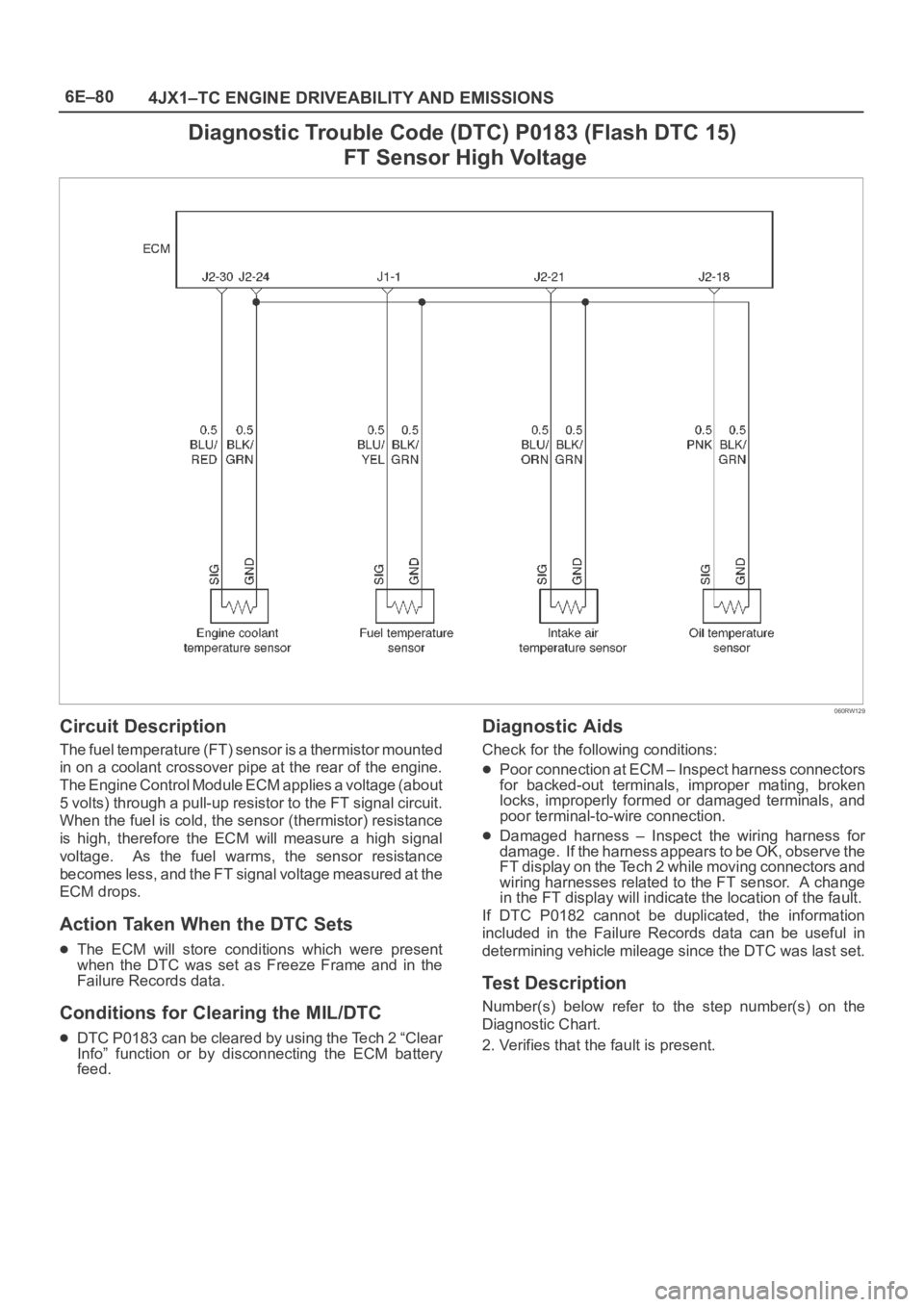
6E–80
4JX1–TC ENGINE DRIVEABILITY AND EMISSIONS
Diagnostic Trouble Code (DTC) P0183 (Flash DTC 15)
FT Sensor High Voltage
060RW129
Circuit Description
The fuel temperature (FT) sensor is a thermistor mounted
in on a coolant crossover pipe at the rear of the engine.
The Engine Control Module ECM applies a voltage (about
5 volts) through a pull-up resistor to the FT signal circuit.
When the fuel is cold, the sensor (thermistor) resistance
is high, therefore the ECM will measure a high signal
voltage. As the fuel warms, the sensor resistance
becomes less, and the FT signal voltage measured at the
ECM drops.
Action Taken When the DTC Sets
The ECM will store conditions which were present
when the DTC was set as Freeze Frame and in the
Failure Records data.
Conditions for Clearing the MIL/DTC
DTC P0183 can be cleared by using the Tech 2 “Clear
Info” function or by disconnecting the ECM battery
feed.
Diagnostic Aids
Check for the following conditions:
Poor connection at ECM – Inspect harness connectors
for backed-out terminals, improper mating, broken
locks, improperly formed or damaged terminals, and
poor terminal-to-wire connection.
Damaged harness – Inspect the wiring harness for
damage. If the harness appears to be OK, observe the
FT display on the Tech 2 while moving connectors and
wiring harnesses related to the FT sensor. A change
in the FT display will indicate the location of the fault.
If DTC P0182 cannot be duplicated, the information
included in the Failure Records data can be useful in
determining vehicle mileage since the DTC was last set.
Test Description
Number(s) below refer to the step number(s) on the
Diagnostic Chart.
2. Verifies that the fault is present.
Page 5510 of 6000
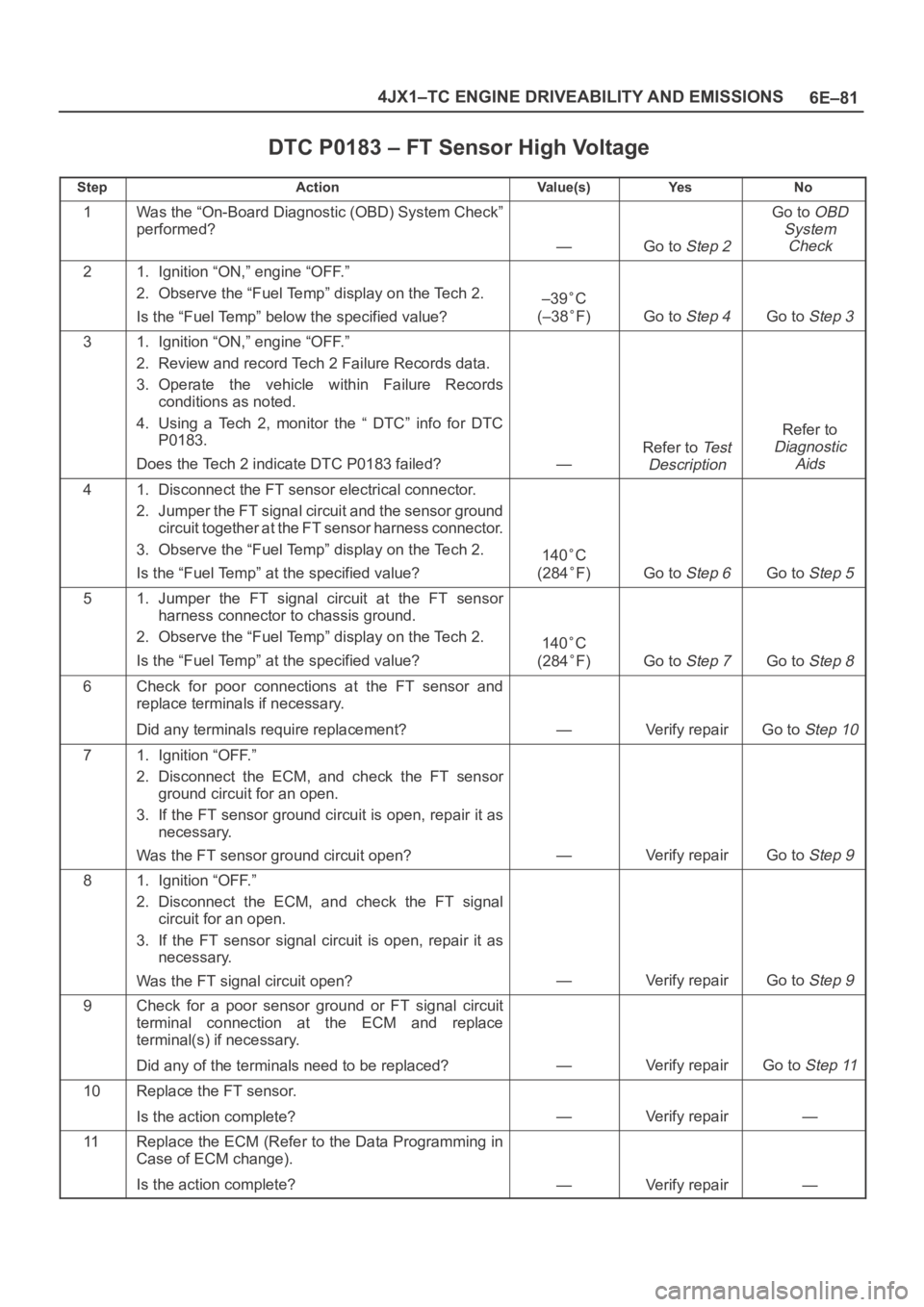
6E–81 4JX1–TC ENGINE DRIVEABILITY AND EMISSIONS
DTC P0183 – FT Sensor High Voltage
StepActionVa l u e ( s )Ye sNo
1Was the “On-Board Diagnostic (OBD) System Check”
performed?
—Go to Step 2
Go to OBD
System
Check
21. Ignition “ON,” engine “OFF.”
2. Observe the “Fuel Temp” display on the Tech 2.
Is the “Fuel Temp” below the specified value?
–39C
(–38
F)Go to Step 4Go to Step 3
31. Ignition “ON,” engine “OFF.”
2. Review and record Tech 2 Failure Records data.
3. Operate the vehicle within Failure Records
conditions as noted.
4. Using a Tech 2, monitor the “ DTC” info for DTC
P0183.
Does the Tech 2 indicate DTC P0183 failed?
—
Refer to Te s t
Description
Refer to
Diagnostic
Aids
41. Disconnect the FT sensor electrical connector.
2. Jumper the FT signal circuit and the sensor ground
circuit together at the FT sensor harness connector.
3. Observe the “Fuel Temp” display on the Tech 2.
Is the “Fuel Temp” at the specified value?
140C
(284
F)Go to Step 6Go to Step 5
51. Jumper the FT signal circuit at the FT sensor
harness connector to chassis ground.
2. Observe the “Fuel Temp” display on the Tech 2.
Is the “Fuel Temp” at the specified value?
140C
(284
F)Go to Step 7Go to Step 8
6Check for poor connections at the FT sensor and
replace terminals if necessary.
Did any terminals require replacement?
—Verify repairGo to Step 10
71. Ignition “OFF.”
2. Disconnect the ECM, and check the FT sensor
ground circuit for an open.
3. If the FT sensor ground circuit is open, repair it as
necessary.
Was the FT sensor ground circuit open?
—Verify repairGo to Step 9
81. Ignition “OFF.”
2. Disconnect the ECM, and check the FT signal
circuit for an open.
3. If the FT sensor signal circuit is open, repair it as
necessary.
Was the FT signal circuit open?
—Verify repairGo to Step 9
9Check for a poor sensor ground or FT signal circuit
terminal connection at the ECM and replace
terminal(s) if necessary.
Did any of the terminals need to be replaced?
—Verify repairGo to Step 11
10Replace the FT sensor.
Is the action complete?
—Verify repair—
11Replace the ECM (Refer to the Data Programming in
Case of ECM change).
Is the action complete?
—Verify repair—
Page 5521 of 6000
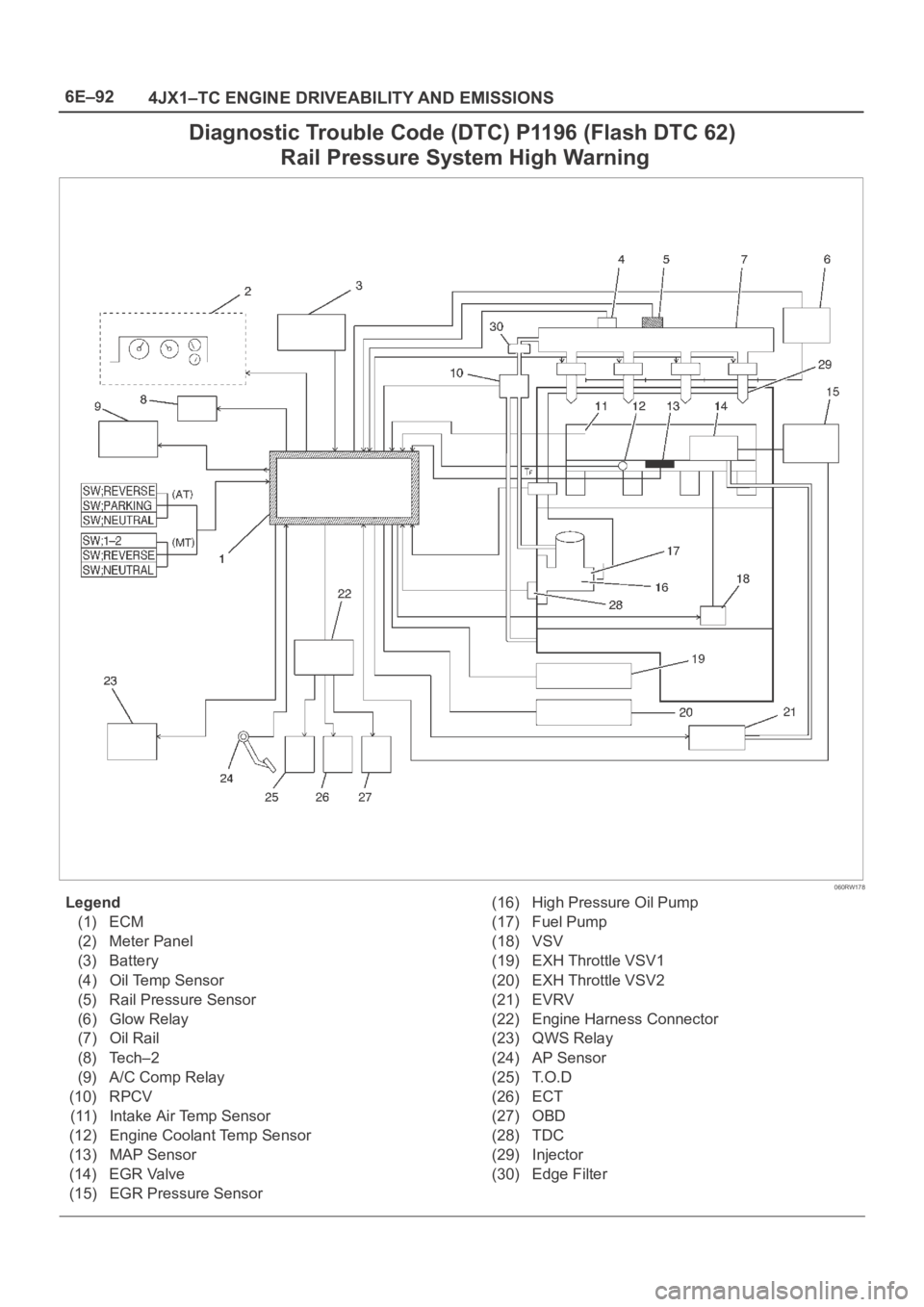
6E–92
4JX1–TC ENGINE DRIVEABILITY AND EMISSIONS
Diagnostic Trouble Code (DTC) P1196 (Flash DTC 62)
Rail Pressure System High Warning
060RW178
Legend
(1) ECM
(2) Meter Panel
(3) Battery
(4) Oil Temp Sensor
(5) Rail Pressure Sensor
(6) Glow Relay
(7) Oil Rail
(8) Tech–2
(9) A/C Comp Relay
(10) RPCV
(11) Intake Air Temp Sensor
(12) Engine Coolant Temp Sensor
(13) MAP Sensor
(14) EGR Valve
(15) EGR Pressure Sensor(16) High Pressure Oil Pump
(17) Fuel Pump
(18) VSV
(19) EXH Throttle VSV1
(20) EXH Throttle VSV2
(21) EVRV
(22) Engine Harness Connector
(23) QWS Relay
(24) AP Sensor
(25) T.O.D
(26) ECT
(27) OBD
(28) TDC
(29) Injector
(30) Edge Filter
Page 5548 of 6000
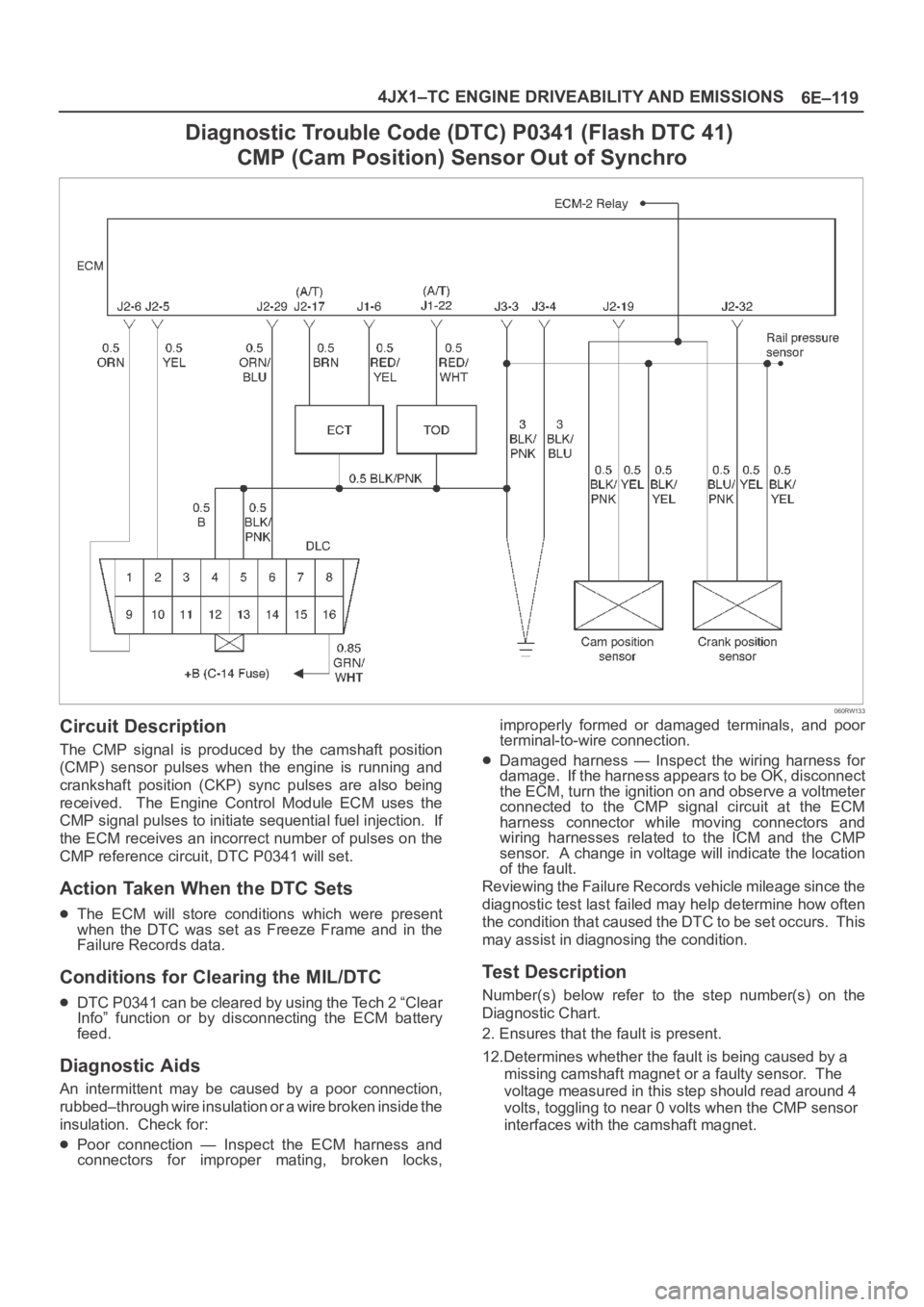
6E–119 4JX1–TC ENGINE DRIVEABILITY AND EMISSIONS
Diagnostic Trouble Code (DTC) P0341 (Flash DTC 41)
CMP (Cam Position) Sensor Out of Synchro
060RW133
Circuit Description
The CMP signal is produced by the camshaft position
(CMP) sensor pulses when the engine is running and
crankshaft position (CKP) sync pulses are also being
received. The Engine Control Module ECM uses the
CMP signal pulses to initiate sequential fuel injection. If
the ECM receives an incorrect number of pulses on the
CMP reference circuit, DTC P0341 will set.
Action Taken When the DTC Sets
The ECM will store conditions which were present
when the DTC was set as Freeze Frame and in the
Failure Records data.
Conditions for Clearing the MIL/DTC
DTC P0341 can be cleared by using the Tech 2 “Clear
Info” function or by disconnecting the ECM battery
feed.
Diagnostic Aids
An intermittent may be caused by a poor connection,
rubbed–through wire insulation or a wire broken inside the
insulation. Check for:
Poor connection — Inspect the ECM harness and
connectors for improper mating, broken locks,improperly formed or damaged terminals, and poor
terminal-to-wire connection.
Damaged harness — Inspect the wiring harness for
damage. If the harness appears to be OK, disconnect
the ECM, turn the ignition on and observe a voltmeter
connected to the CMP signal circuit at the ECM
harness connector while moving connectors and
wiring harnesses related to the ICM and the CMP
sensor. A change in voltage will indicate the location
of the fault.
Reviewing the Failure Records vehicle mileage since the
diagnostic test last failed may help determine how often
the condition that caused the DTC to be set occurs. This
may assist in diagnosing the condition.
Test Description
Number(s) below refer to the step number(s) on the
Diagnostic Chart.
2. Ensures that the fault is present.
12.Determines whether the fault is being caused by a
missing camshaft magnet or a faulty sensor. The
voltage measured in this step should read around 4
volts, toggling to near 0 volts when the CMP sensor
interfaces with the camshaft magnet.